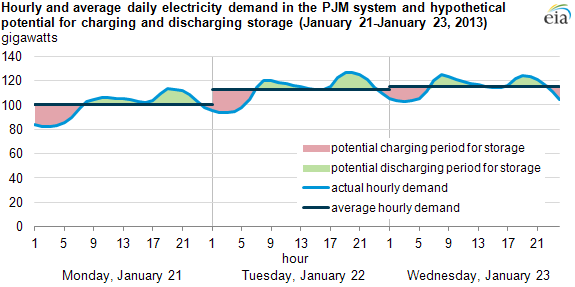
Variability in electricity demand highlights potential roles for electricity storage

Note: Demand for the East Kentucky Power Cooperative, which joined PJM on June 1, 2013, is not included in the regional demand estimate above to ensure a consistent footprint throughout the selected time horizon.
The availability of significant storage capacity could help to decouple electricity supply needs from variable electricity demand. However, based on this analysis of PJM Interconnection (PJM) hourly demand data from August 2012 to July 2013, a large amount of storage capacity would be required to reduce the variability in electricity supply needs over different time periods.
A previous Today in Energy article noted that because the electric industry lacks large-scale storage, supply has to adjust in real time to match demand. Hourly demand varies significantly over the day, week, and year. This suggests three potential modes for framing storage capacity requirements. Storage can charge and discharge over a day, yielding a flat supply need equal to the daily average of hourly demand (see chart above); over a week at the weekly average, or over the year at the annual average. This analysis shows that the storage capacity requirement grows significantly as storage operations move from the daily to the weekly to the annual demand cycles.
There are a variety of storage technologies used in the electric industry, such as pumped storage, compressed air, and flywheels. These technologies convert electricity into another form of energy for storage: the potential energy in water pumped uphill to a reservoir and in compressed air, and the momentum in a weight spinning at high speed. But storage in the amounts needed to flatten daily, weekly, or annual supply needs, while meeting instantaneous demand, is far above the current available level.
However, if large-scale storage of electricity were feasible and economical, electricity supply could be separated from instantaneous demand, thereby reducing the requirement for supply.
Potential value of electricity storage over different time horizons
In theory, it may be possible to store electricity overnight on a large scale to supply afternoon highs (daily), on weekends to supply weekday highs (weekly), and in the spring and the fall to supply summer and winter peaks (annual). Each of these storage opportunities would likely require different storage approaches and technologies.
| Storage Goal | Maximum Storage Capacity (GWh) | Maximum Charging Rate (GW/hr) | Maximum Discharge Rate (GW/hr) | Supply Requirement (Reductions) (GW) | |
|---|---|---|---|---|---|
| Daily | 258 | 37 | (30) | 130 (25) | |
| Weekly | 1,867 | 39 | (42) | 117 (38) | |
| Annual | 22,917 | 33 | (66) | 89 (66) | |
Source: U.S. Energy Information Administration, based on PJM data. | |||||
Based on the August 2012 through July 2013 PJM hourly demand data (see table), storage sufficient to reduce hourly supply needs to the daily average demand would have to be able to store up to 258 gigawatthours (GWh), charge at a rate of 37 GW per hour, and discharge at 30 GW per hour. Such storage has the potential to reduce the peak-hour supply requirement from 155 GW to 130 GW, a reduction of 25 GW (see chart below).
Storage that would be sufficient to reduce hourly supply needs to the weekly average demand would have to be able to store up to 1,867 GWh, charge at a rate of 39 GW per hour, and discharge at 42 GW per hour. Such storage has the potential to reduce the peak-hour supply requirement from 155 GW to 117 GW, a reduction of 38 GW (see chart).
Storage that would be sufficient to reduce hourly supply needs to the annual average demand would have to be able to store up to 22,917 GWh, charge at a rate of 33 GW per hour, and discharge at 66 GW per hour. Such storage has the potential of reducing the peak-hour supply requirement from 155 GW to 89 GW, a reduction of 66 GW (see chart).
These storage capacity values are large, and technology does not exist currently to provide it economically.

Source: U.S. Energy Information Administration, based on PJM data
Note: Demand for East Kentucky Power Cooperative, which joined PJM on June 1, 2013, is not included to maintain a consistent footprint throughout the year.

Source: U.S. Energy Information Administration, based on PJM data
Note: Demand for East Kentucky Power Cooperative, which joined PJM on June 1, 2013, is not included to maintain a consistent footprint throughout the year.

Source: U.S. Energy Information Administration, based on PJM data
Note: Demand for East Kentucky Power Cooperative, which joined PJM on June 1, 2013, is not included to maintain a consistent footprint throughout the year.
Other considerations
Significant electricity storage would allow much of the generator fleet to operate at a constant output level as baseload capacity. Demand-response programs and technologies that tend to reduce the variability of hourly electric demand and the resulting supply requirement would reduce the need for electricity storage.
Principal contributor: William Booth
Tags: capacity, consumption/demand, electricity, storage, storage